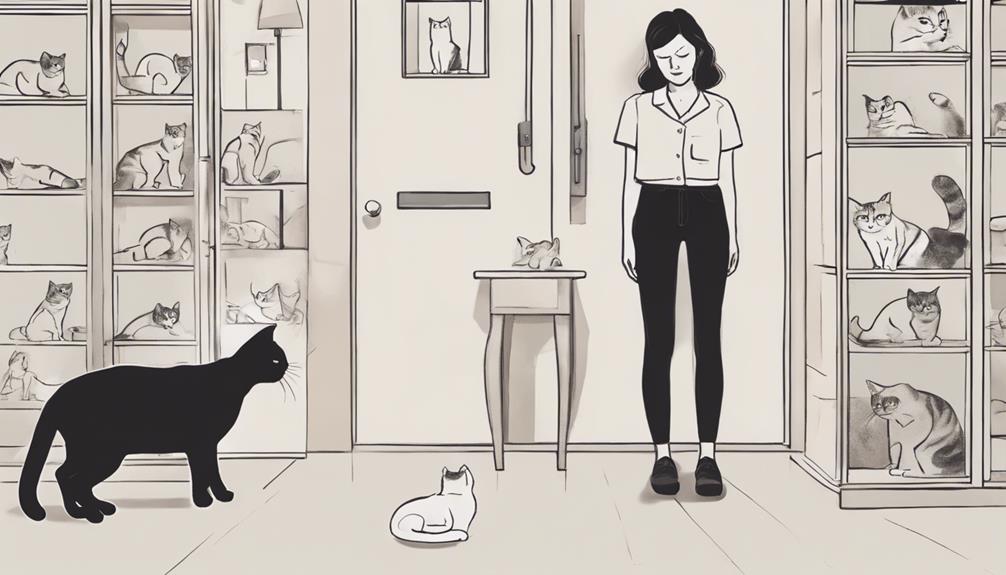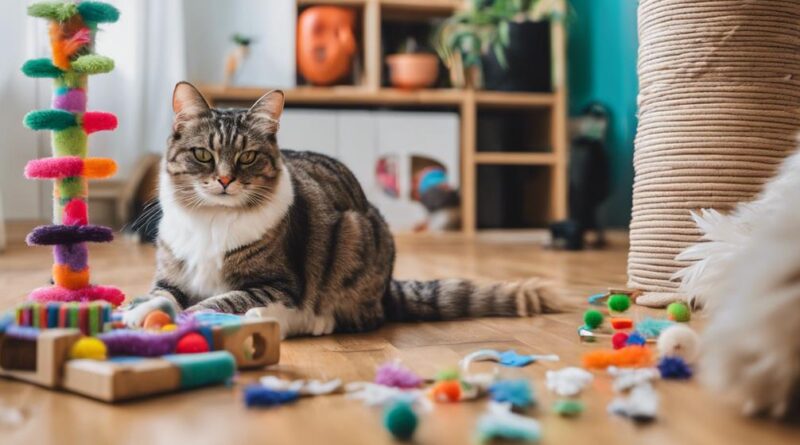12 Proven Methods for Training Cats With Psychology
Have you ever wondered how you could use psychology to train your feline friend effectively?
From understanding cat behavior patterns to incorporating play therapy, there are numerous proven methods that can help you build a strong bond with your cat.
Each technique is grounded in psychological principles tailored to the unique way cats think and learn.
By exploring these strategies, you can unlock the secrets to successful cat training and witness the incredible results firsthand.
Understanding Cat Behavior Patterns
To effectively train your cat, observing and understanding their behavior patterns is essential. Cats have specific behavioral triggers that lead to various response patterns. By paying attention to these triggers and responses, you can better comprehend your feline friend.
Instinctual behaviors, such as hunting or marking territory, play a significant role in how cats interact with their environment. Understanding these instinctual behaviors can help you predict how your cat will react in certain situations.
Social interactions also heavily influence a cat's behavior. Whether your cat is solitary or enjoys the company of other animals, their social tendencies impact how they respond to training. Some cats may be more independent and less receptive to certain training methods, while others thrive on social interaction and positive reinforcement.
Positive Reinforcement Techniques
Positive reinforcement techniques are effective ways to encourage desired behaviors in your cat. When it comes to training your feline friend, utilizing positive reinforcement can lead to more successful outcomes. One popular method is clicker training, which involves using a clicker to create a sound associated with a reward. This technique helps in marking the exact moment your cat performs the desired behavior, making it easier for them to understand what they're being rewarded for.
Clicker training offers several benefits, such as precise timing in marking behaviors, which helps in clear communication with your cat. It also allows for consistency in rewarding good behavior, making the training process more efficient. However, clicker training may present challenges, like some cats being sensitive to the sound or needing time to associate it with rewards.
In addition to clicker training, rewarding good behavior techniques are essential in positive reinforcement. Offering treats, verbal praise, or extra playtime can reinforce the behavior you want to see more of in your cat. Remember to reward your cat immediately after they exhibit the desired behavior to strengthen the association between the action and the reward. By consistently using positive reinforcement techniques, you can effectively train your cat and build a strong bond based on trust and communication.
Using Clicker Training Effectively
For optimal results in training your cat with clicker training, precision in timing the click is crucial. Clicker training benefits from precise timing as it helps your cat associate the click with the desired behavior more effectively.
Here are some key points to consider when using clicker training with your feline friend:
- Enhanced Communication: Clicker training provides a clear and consistent way to communicate with your cat, helping them understand exactly which behaviors lead to rewards. This clarity can strengthen the bond between you and your pet, fostering a deeper understanding.
- Limitations of Clicker Training: While clicker training is a powerful tool, it may not work for every cat. Some cats may be sensitive to the sound of the clicker or may not respond well to this type of training. It's essential to observe your cat's reactions and adjust your training methods accordingly.
- Mastering Timing Accuracy: Achieving precise timing in clicker training requires practice and attentiveness. By clicking at the exact moment your cat performs the desired behavior, you reinforce the connection between the action and the reward. Consistent and accurate timing is key to successful clicker training sessions.
Implementing Desensitization Strategies
Implement desensitization strategies by gradually exposing your cat to stimuli that trigger anxiety or fear, promoting a more relaxed and confident feline behavior. By incorporating gradual exposure techniques, you can help your cat overcome its fears in a systematic manner. This method involves exposing your cat to the fear-inducing stimulus at a low intensity initially and then slowly increasing the exposure over time.
Systematic desensitization aims to change your cat's response to the fearful stimulus by replacing the anxious reaction with a calmer one through repeated and controlled exposure. For instance, if your cat is scared of loud noises, start by playing a recording of the noise at a very low volume. As your cat becomes comfortable, gradually increase the volume over several sessions. This gradual approach can help your cat build confidence and reduce anxiety.
Counterconditioning is another useful technique where you pair the fear-triggering stimulus with something positive to create a new association. For example, if your cat is scared of the carrier, you can start by placing treats near it to create a positive association. Over time, your cat will learn to associate the carrier with treats, helping to reduce its fear and anxiety.
Utilizing Operant Conditioning Methods
Utilize operant conditioning methods to train your cat effectively and reinforce desired behaviors. Behavior modification through operant conditioning involves shaping your cat's behavior by providing consequences based on their actions. By understanding reinforcement schedules, you can effectively train your cat to exhibit specific behaviors consistently.
Here are three key points to consider when utilizing operant conditioning methods with your feline friend:
- Positive Reinforcement: Reward your cat with treats, toys, or affection immediately after they perform the desired behavior. This positive association encourages them to repeat the behavior in the future.
- Negative Reinforcement: Remove an unpleasant stimulus when your cat displays the desired behavior. For example, stop a loud noise when they use the scratching post instead of the furniture. This helps reinforce the behavior through the removal of an aversive stimulus.
- Consistency is Key: Be consistent in your approach to reinforcement. Establish clear cues for your cat to understand when they're behaving correctly. Consistent reinforcement helps solidify the desired behavior over time.
Applying Environmental Enrichment Concepts
To further enhance your cat's training and well-being, consider incorporating environmental enrichment concepts into their living space. Behavior modification can be facilitated through enrichment activities that stimulate your cat both mentally and physically. Cats are natural hunters and providing them with interactive toys that mimic prey can satisfy their instincts and prevent behavioral issues like excessive meowing or scratching.
Enrichment activities such as puzzle feeders can encourage your cat to problem-solve and stay mentally sharp. By making mealtime more engaging, you can prevent boredom and decrease the likelihood of destructive behaviors. Additionally, rotating toys and introducing new ones regularly can keep your cat curious and engaged in their environment.
Creating vertical spaces in your home, like cat trees or shelves, allows your cat to climb and perch, mimicking their natural habitat. This can help reduce stress and provide a sense of security for your feline friend. Providing hiding spots and cozy resting areas can also promote feelings of safety and comfort.
Reading Feline Body Language Cues

Understanding your cat's body language cues is essential for building a strong bond and effective communication with your feline companion. By interpreting signals and paying attention to their nonverbal communication, you can deepen your understanding of your cat's feelings and needs.
Here are some key cues to look out for:
- Tail Position: A cat's tail can convey a lot about their mood. A raised tail indicates happiness, while a tucked tail may signal fear or submission.
- Ear Movements: The position of your cat's ears can also provide valuable insights. Forward-facing ears denote interest or curiosity, while flattened ears may indicate aggression or discomfort.
- Purring: While commonly associated with contentment, cats may also purr when stressed or in pain. Understanding the context in which your cat purrs is crucial for accurate interpretation.
Incorporating Play Therapy for Cats
Engaging in interactive play sessions can significantly enhance your cat's well-being and strengthen your bond with them. Interactive toys play a crucial role in providing mental stimulation for your feline friend. Cats are natural hunters, and interactive toys mimic this behavior, keeping them mentally engaged and physically active.
Introducing a variety of interactive toys can prevent boredom and behavioral issues in your cat. Toys like feather wands, puzzle feeders, and laser pointers can stimulate their predatory instincts, providing an outlet for their energy. Rotate these toys regularly to maintain your cat's interest and prevent them from losing novelty.
Playing with interactive toys not only keeps your cat physically active but also provides mental enrichment. The mental stimulation offered by these toys can prevent cognitive decline in older cats and help kittens develop essential skills. Additionally, interactive play sessions can alleviate stress and anxiety in cats by allowing them to release pent-up energy in a positive way.
Incorporating play therapy into your cat's routine is a fun and effective way to strengthen your bond while promoting their overall well-being. So, grab a feather wand or a puzzle feeder, and engage your feline companion in enriching play sessions that benefit both their body and mind.
Frequently Asked Questions
Can I Use Psychology Training Methods to Teach My Cat Tricks Like Rolling Over or Playing Dead?
Yes, you can definitely use psychology training methods to teach your cat tricks like rolling over or playing dead. Understanding feline behavior is key. Using operant conditioning techniques and positive reinforcement in cat training can be effective.
Patience and consistency are important. By rewarding desired behaviors, you can successfully train your cat to perform tricks. Remember, each cat is unique, so tailor your training approach to suit your feline friend's personality.
How Long Does It Typically Take to See Results When Using Positive Reinforcement Techniques to Train a Cat?
When you're training your cat using positive reinforcement techniques, tracking progress is key. Results can vary depending on your cat's personality and the behavior you're working on.
Typically, you might start seeing some changes within a few days to a couple of weeks. Remember, consistency is crucial in reinforcement schedules.
Stay patient and keep reinforcing positive behaviors to help your cat learn new tricks or behaviors effectively.
Are There Any Specific Clicker Training Exercises That Work Best for Older Cats?
When training older cats with clicker exercises, focus on their feline behavior and cognitive development. Start with simple tasks like targeting or recall to engage their mind.
Gradually increase difficulty to keep them challenged. Remember to be patient and consistent in your training approach. Positive reinforcement is key to motivating them.
What Are Some Common Mistakes to Avoid When Implementing Desensitization Strategies With a Cat?
When implementing desensitization strategies with your cat, common mistakes to avoid include moving too quickly, forcing interactions, or not being consistent. Remember, desensitization takes time and patience.
Start slow, gradually exposing your cat to triggers while rewarding calm behavior. Keep sessions short and positive to prevent overwhelming your cat.
Can Operant Conditioning Methods Be Used to Address Aggression or Territorial Behavior in Cats?
When dealing with feline aggression or territorial issues, using operant conditioning methods can be beneficial. By setting clear boundaries and consistently rewarding desired behaviors, you can effectively address these behavioral problems in cats.
Behavioral modification techniques can help reshape your cat's responses and reactions, promoting a more harmonious relationship between you and your feline friend. Remember, patience and consistency are key when working on behavior modification with cats.
Conclusion
Now that you have learned these 12 proven methods for training your cat using psychology, you can start implementing them to see positive results.
Remember to be patient and consistent in your approach, as cats respond well to positive reinforcement and environmental enrichment.
By understanding your cat's behavior patterns and utilizing these techniques effectively, you can build a strong bond with your feline friend and create a harmonious environment for both of you to enjoy.
